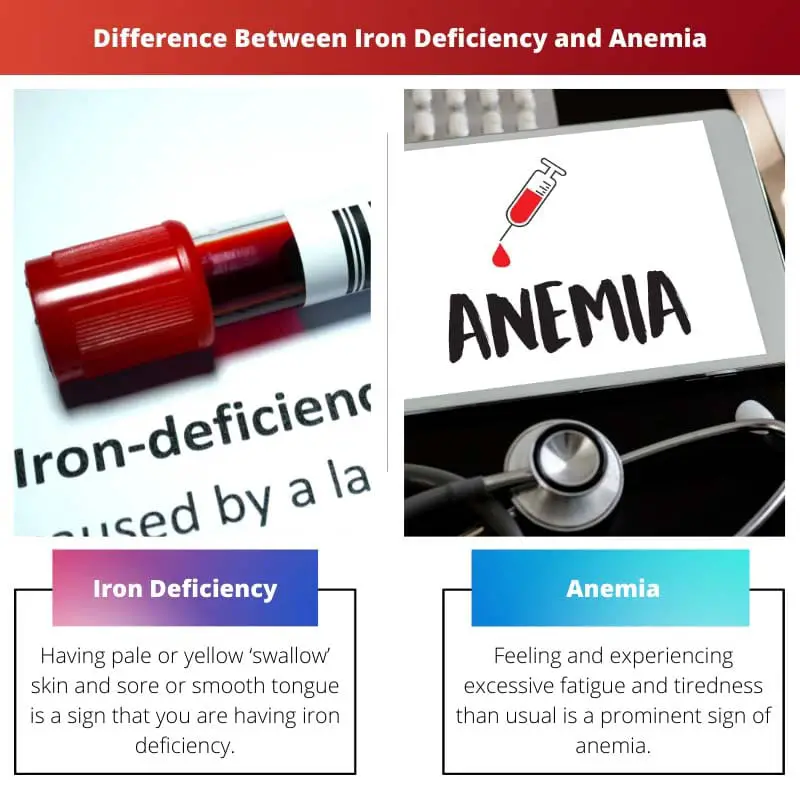Iron Deficiency and Anaemia are the two words we hear and many times interchangeably. But there is a very thin line of difference between the two terms. Iron deficiency, as the name itself suggests, refers to the insufficiency of iron in the body.
In contrast, Anaemia is a condition where the body is deficient in adequate healthy red blood cells. Iron deficiency is one of the many types of Anaemia.
Key Takeaways
- Iron deficiency occurs when the body lacks enough iron to produce hemoglobin, while a lack of healthy red blood cells causes anemia.
- Iron deficiency is the most common cause of anemia, but anemia can result from other factors such as vitamin deficiencies or chronic diseases.
- Iron deficiency and anemia symptoms can overlap, including fatigue, weakness, and pale skin, but a blood test is necessary for an accurate diagnosis.
Iron Deficiency vs Anaemia
Iron deficiency occurs when the body does not have enough iron to produce haemoglobin, which is the protein in red blood cells that carries oxygen throughout the body. Anaemia is a condition that occurs when the body does not have enough red blood cells or haemoglobin to carry oxygen to the body’s tissues. There are several types of anaemia.

While Anaemia is a situation where the red blood cells lack oxygen content, i.e., haemoglobin, red blood cells are responsible for providing oxygen to various body tissues.
Haemoglobin is required to carry oxygen, and if there is a scarcity of haemoglobin or there are many abnormal red blood cells, this would reduce the capacity of blood to carry oxygen to body tissues.
Iron deficiency means having insufficient iron in the body. Iron is an important constituent or element when it comes to making red blood cells. When the body lacks iron, it cannot produce enough content in the red blood cells.
This content is necessary as it enables the blood to carry oxygen (haemoglobin) to blood tissues. Haemoglobin is an iron-rich content. If not taken proper supplementation, this could lead to Iron deficiency anaemia.
Comparison Table
| Parameters of Comparison | Iron Deficiency | Anaemia |
|---|---|---|
| Identification | Having pale or yellow ‘swallow’ skin and sore or smooth tongue is a sign that you are having iron deficiency. | Feeling and experiencing excessive fatigue and tiredness than usual is a prominent sign of anaemia. |
| Severity | If not taken proper treatment, it could lead to rapid or irregular heartbeat leading to several heart problems. | Some types of anaemia have life-threatening effects. Losing a lot of blood cells could be fatal. |
| Causes | Dietary deficiency (of iron), malabsorption of nutrients or pregnancy are some of the most common causes. | Blood loss, inherited disorders, chronic diseases, hormone disorders, or infections are its common causes. |
| Symptoms | Its symptoms are extreme fatigue, weakness, pale skin, chest pain, headache, smaller and paler RBCs, and low level of ferritin (protein-type). | Its symptoms are easy fatigue or loss of energy, insomnia, leg cramps, or difficulty while concentrating. |
| Treatment | Iron deficiency could be cured by taking iron supplements, also called iron pills or oral iron. | Blood transfusion, colonoscopy, bone marrow transplant, or oxygen therapy are some of the treatments. It varies as per the type of anaemia. |
What is Iron Deficiency?
Iron deficiency is considered to be the most common form of anaemia. It occurs when the blood doesn’t have adequate healthy red blood cells, which in turn is due to a lack of iron.
Iron helps in making red blood cells. It is a key part of red blood cells. Without enough iron content, the blood cannot effectively carry oxygen to the body tissues. We get iron, generally, from our diet.
Also, our body uses iron from old red blood cells. Young children and menstruating or pregnant women are more prone to getting affected by this type of anaemia.
Iron deficiency occurs when the iron stored in the body runs too low.
It is due to losing more red blood cells and iron than required for the body to replace them, or due to lack of an iron-rich diet; or due to malabsorption, when the intestines are unable to absorb iron; also, when the body requires iron, more than normal, in special conditions, like during pregnancy or breastfeeding.
The symptoms of iron deficiency anaemia are very mild at the initial stages and go unnoticed.
You may feel extreme fatigue, shortness of breath; pale and swallow skin, at times, yellow, brittle nails; sometimes you also experience strange cravings to eat items that are not food, such as dirt, clay, ice or sand; sore and smooth tongue; and rapid or irregular heartbeats are also some of the signs.

What is Anaemia?
Anaemia is a type of disease where the body lacks red blood cells. Red blood cells carry oxygen to different body tissues. When the red blood cells count is low, it simply means that there is not enough oxygen in the blood, as normally required.
Haemoglobin is a key part when detecting anaemia. It is a protein within the red blood cells that carries oxygen from the lungs to the other body tissues.
Main symptoms of anaemia are noticed due to a decrease in oxygen availability in vital organs of the body, such as feeling short of breath, having a headache or chest pain, feeling cold, getting irritated more often, irregular heartbeat, skin rashes, etc.
Every year, millions of people get affected due to anaemia. Women and people with chronic diseases are more likely to get affected by it.
Anaemia is mainly caused due to reduced red blood cells production, inherent disorders, blood loss, particularly during heavy periods, blood disorders such as sickle cell anaemia and thalassemia, or cancer, aplastic anaemia (where the bone marrow doesn’t make enough RBCs), or metabolic and hormone disorders.
For the treatment of Anaemia, the first diagnosis is made by doing Complete Blood Count (CBC) to determine the level of blood cells in the body, and based on the underlying condition, further medications and therapies are advised.

Main Differences Between Iron Deficiency and Anaemia
- Anaemia is the insufficiency of adequate red blood cells that are healthy, which further prevents oxygen transmission in the body, whereas Iron deficiency is the most common type of anaemia and occurs due to a lack of iron constitution in the body.
- Iron deficiency, if not properly treated, may lead to Anaemia, whereas an anaemic person could be iron deficient or not.
- Iron deficiency is a type of anaemia and is not fatal, whereas anaemia causes pale and swallow skin, looking yellowish.
- Iron deficiency is quite easily recoverable. On the other hand, anaemia involves complex surgeries and advanced medications.
- Iron deficiency is not inheritable, whereas anaemia is mainly inherited.




